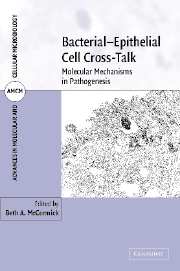Book contents
- Frontmatter
- Contents
- List of contributors
- Part I Introduction to the host and bacterial pathogens
- Part II Bacterial cell biology and pathogenesis
- 3 Bacterial secretion systems
- 4 Microbial molecular patterns and host defense
- 5 Roles of flagella in pathogenic bacteria and bacterial–host interactions
- 6 The role of bacterial adhesion to epithelial cells in pathogenesis
- 7 Bacterial toxins that modify the epithelial cell barrier
- Part III Host cell signaling by bacteria
- Part IV Exploitation of host niches by pathogenic bacteria: mechanisms and consequences
- Index
- Plate section
- References
7 - Bacterial toxins that modify the epithelial cell barrier
from Part II - Bacterial cell biology and pathogenesis
Published online by Cambridge University Press: 12 August 2009
- Frontmatter
- Contents
- List of contributors
- Part I Introduction to the host and bacterial pathogens
- Part II Bacterial cell biology and pathogenesis
- 3 Bacterial secretion systems
- 4 Microbial molecular patterns and host defense
- 5 Roles of flagella in pathogenic bacteria and bacterial–host interactions
- 6 The role of bacterial adhesion to epithelial cells in pathogenesis
- 7 Bacterial toxins that modify the epithelial cell barrier
- Part III Host cell signaling by bacteria
- Part IV Exploitation of host niches by pathogenic bacteria: mechanisms and consequences
- Index
- Plate section
- References
Summary
INTRODUCTION
Bacterial pathogens utilize invasive pathways and/or toxins to subvert the innate and acquired immune systems in order to damage the host epithelium. The infectious process requires that the pathogen can adhere and proliferate in the host. The capacity to colonize and cause disease varies among bacterial pathogens. For example, Clostridium tetani has only a limited ability to bind and proliferate within the host but is pathogenic due to the production of a potent neurotoxin, but the streptococcus and staphylococcus have strong adhesion factors that allow efficient colonization, with virulence due to the production of a multitude of virulence factors, including superantigens that simultaneously bind the major histocompatibility complex (MHC) and T-cell receptor of immune cells to stimulate production of antigen-independent cytokines.
The basic distinction between a member of our normal flora and a pathogen lies in the capacity to damage the host. However, this distinction is grayed by the immune status of the host, where host compromise converts commensal bacteria or even saprophytic bacteria into potent opportunistic pathogens. Pseudomonas aeruginosa is an opportunistic pathogen in many clinical situations but does not elicit disease in healthy individuals despite its ability to produce both a classical exotoxin and type III cytotoxins. Clostridium difficile can cause pseudomembrane colitis in patients undergoing antibiotic therapy. C. difficile pathogenesis is related to the ability to produce the exotoxins, toxin A and toxin B. Escherichia coli, a component of our normal gut flora, becomes a pathogen upon the acquisition of accessory genes that can encode several classes of toxins.
- Type
- Chapter
- Information
- Bacterial-Epithelial Cell Cross-TalkMolecular Mechanisms in Pathogenesis, pp. 184 - 210Publisher: Cambridge University PressPrint publication year: 2006
References
- 1
- Cited by



